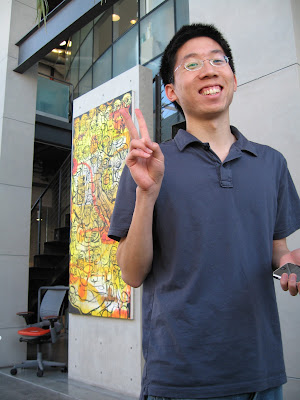However, we managed to drag ourselves to MicroPlace on time, and hearing about the organization from Ashwini Narayanan, the chief operating officer and head of product management, we realize the visit was well worth the early wakeup time. Microplace takes a very different approach than most nonprofit organizations. Instead of targeting the $250 billion in capital available for charity, Microplace reaches out to the $2.5 trillion available for investments. Donors invest a small amount of money in certain Microfinance Institutes, which then use this money to provide small loans to people in developing countries. The return on the original investment for donor is about 3%- the typical amount people get some CDs. Microplace provides a way for people to make money and SAVE the WORLD.
After visiting Microplace, Shazad, David, and I got into a spirited debate over which organization was better- KIVA or Microplace. By putting pictures of the people who need loans on its site, KIVA entices people to lend money by tugging at people’s heartstrings. However, Microplace does not relay upon altruism by giving people a return on their investment. Ashwini made a good point in her lecture that there is place for both organizations as the two target different types of donors. The great thing about organizations with social missions is that they help each other. While in the for-profit world companies often aim to destroy all competition, nonprofits aim to produce social change. The elimination of poverty needs both KIVA and Microplace.
Lenders for Community Development (LCD) was the next organization we visited. Instead of government programs, like Welfare, that discourage savings by taking away benefits if a certain income is achieved, LCD provides positive reinforcement through their two to one matching ratio for savings, such that for every one dollar people save, they will receive two in return. LCD took us to visit some of the amazing people it had helped. We meet Robert and Jane Sissons, the two wonderful people who own Evolution Suspension. With the loan from LCD, they were able to expand their thriving bike repair shop. The work that LCD does is amazing. It doesn’t provide a gift, but gives a small lift to help people become successful.

Monday ended with a dinner with Heather McLeod Grant, author of “Forces for Good: The Six Practices of High-Impact Nonprofits”. The discussion touched on a number of issues including the importance of relationships and social networks, the different methods of doing good, and the multitude of career paths on the road to becoming a social entrepreneur. Grant mentioned that the importance of relationships and social networks as key enablers in mobilizing people around a nonprofit’s mission seemed to be a recurring theme that characterized successful nonprofits. Our discussion also touched on the multitude of career paths that an individual could take on the road towards working in a nonprofit or social enterprise. The general consensus seemed to be that going from Stanford to McKinsey/Goldman to a Nonprofit was easier than going from Stanford to a Nonprofit to Private Industry.
Random Reflections from our conversation afterwards:
-Don’t get married or have kids. It’s not particularly conducive to spend your time with family when you’re bogged down in trying to save the world. David’s theory of population control: Make 1/3 of the world social entrepreneurs.
-Going into private industry first tends to be more useful than going straight into the nonprofit world
-Spend time developing social networks while you’re at Stanford, and don’t burn bridges. That conservative kid down the hall with the wealthy dad might end up becoming attorney general
-Finding a passion is hard and it changes over time. You have to expose yourself to different experiences to find out what you really like. As you age, your interests and priorities will change as well.
No comments:
Post a Comment